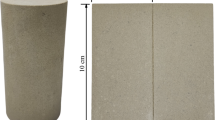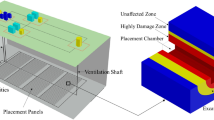Abstract
We review transient creep and semibrittle behavior of crystalline solids. The results are expected to be pertinent to crystalline rocks undergoing deformation in the depth range 5 to 20 km, corresponding to depths of focus of many major earthquakes. Transient creep data for crystalline rocks at elevated temperatures are analyzed but are poorly understood because of lack of information on the deformation processes which, at low to moderate pressure, are likely to be semibrittle in nature. Activation energies for transient creep at high effective confining pressure are much higher than those found for atmospheric pressure tests in which thermally-activated microfracturing probably dominates the creep rate. Empirical transient creep equations are extrapolated at 200° to 600°C, stresses from 0.1 to 1.0 kbar, to times ranging from 3.17×102 to 3.17×108 years. At the higher temperatures, appreciable transient creep strains may take place but the physical significance of the results is in question because the flow mechanisms have not been determined. The purpose of this paper is to stimulate careful research on this important topic.
Similar content being viewed by others
References
Afrouz, A. andHarvey, J. (1974),Rheology of rocks within the soft to medium strength range, Int. J. Rock Mech. Min. Sci.11, 281–290.
Amin, K. E., Mukherjee, A. K. andDorn, J. E. (1970),A universal law for high-temperature diffusioncontrolled transient creep, J. Mech. Phys. Solids18, 413–426.
Andrade, C. N. CAC. (1910),Viscous flow in metals, Proc. Roy. Soc. Lon., A.84, 1–12.
Argon, A. S. andOrowan, E. (1964),Plastic deformation in MgO single crystals, Phil. Mag.,9, 1003–1021.
Boullier, A. M. andGueguen, Y. (1975),SP-mylonites: Origin of some mylonites by superplastic flow, Contrib. Mineral. Petrol.50, 93–104.
Brace, W. F., Paulding, B. W. andScholz, C. (1966),Dilatancy in the fracture of crystallne rocks, J. Geophys. Res.71, 3939–3953.
Carter, N. L. (1976),Steady state flow of rocks, Rev. Geophys. Space Phys.14, 301–360.
Carter, N. L. andHeard, H. C. (1970),Temperature and rate dependent deformation of halite, Amer. J. Sci.269, 193–249.
Carter, N. L. andFriedman, M. (1965),Dynamic analysis of deformed quartz and calcite from the Dry Creek Ridge anticline, Montana, Amer. J. Sci.263, 747–785.
Carter, N. L. andRaleigh, C. B. (1969),Principal stress directions from plastic flow in crystals, Geol. Soc. Amer. Bull.80, 1213–1264.
Chen, P. W., Young, C. T., andLytton, J. L. (1975),Effect of dislocation substructure on the primary creep behavior of aluminum at elevated temperatures, inRate Processes in Plastic Deformation of Metals (eds. J. C. M. Li and A. K. Mukherjee) (Amer. Soc. Metals), pp. 605–628.
Christie, J. M., Griggs, D. T. andCarter, N. L. (1964),Experimental evidence of basal slip in quartz, J. Geol.72, 734–756.
Coble, R. L. (1963),A model for boundary diffusion controlled creep in polycrystalline materials, J. Appl. Phys.34, 1679–1682.
Coble, R. L. andParikh, N. M.,Fracture in polycrystalline ceramics, inFracture VII (ed. H. Liebowitz) (Academic Press, 1972), 243–314.
Coe, R. S., andKirby, S. H. (1975),The orthoenstatite to clinoenstatite transformation by shearing and reversion by annealing: mechanism and potential application, Contrib. Mineral. Petrol.52, 29–55.
Conway, J. B. andMullikin, M. J. (1966),A graphical test of the Garofalo equation, Trans. Metall. Soc., AIME236, 940.
Cottrell, A. H.,The Mechanical Properties of Matter, (John Wiley and Sons, New York, 1964), 430 pp.
Cruden, D. M. (1970),A theory of brittle creep in rocks under uniaxial compression, J. Geophys. Res.,75, 3431–3442.
Cruden, D. M. (1974),The static fatigue of brittle rock under uniaxial compression, Int. J. Rock. Mech. Min. Sci.11, 67–73.
Dorn, J. E. (1954),Some fundamental experiments on high-temperature creep, J.Mech. Phys. Solids19, 77–83.
Eaton, S. F.,The high temperature creep of dunite, Ph. D. Thesis (Princeton Univ., Princeton, N.J. 1968).
Elliot, D. (1973),Diffusion flow laws in metamorphic rocks, Geol. Soc. Amer. Bull.84, 2645–2664.
Etheridge, M. A., Hobbs, B. E., andPaterson, M. S. (1973),Experimental deformation of single crystals of biotite, Contrib. Mineral. Petrol.38, 21–36.
Evans, H. E. andWilliams, K. R. (1972),A physical basis for primary recovery creep, Phil. Mag.25, 1399–1408.
Evans, H. E. (1936),The elasticity and plasticity of rocks and artificial stone, Proc. Leeds Phil. Lit. Soc.3, pt. 3, 145–158.
Evans, W. J. andWilshire, B. (1968a),Work-hardening and recovery during transient and steady state creep, Trans. Metall. Soc. AIME,242, 2514–2515.
Evans, W. J. andWilshire, B. (1968b),Transient and steady state creep behavior of nickel. zinc, and iron, Trans. Metall. Soc. AIME,242, 1303–1307.
Garofalo, F.,Fundamentals of creep and creep-rupture in metals (MacMillan, 1965), 258 pp.
Goetze, C. (1971),High temperature rheology of Westerly granite, J. Geophys. Res.,76, 1223–1230.
Goetze, C. andBrace, W. F. (1972),Laboratory observations of high-temperature rheology of rocks, Tectonophysics13, 583–600.
Green, H. W. (1970),Diffusional flow in polycrystalline materials, J. Appl. Phys.41, 3899–3902.
Griggs, D. T. (1936),Deformation of rocks at high confining pressure, J. Geol.44, 541–577.
Griggs, D. T. (1939),Creep of rocks, J. Geol.47, 225–251.
Griggs, D. T. (1940),Experimental flow of rocksunder conditions favoring recrystallization, Geol. Soc. Amen. Bull.51, 1001–1022.
Griggs, D. T. andHandin, J. W. (1960),Observations on fracture and a hypothesis of earthquakes, Geol. Soc. Amer. Mem.79, 347–364, 1960.
Handin, J. W., Hager, R. V., Jr., Friedman, M. andFeather, J. N. (1963),Experimental deformation of sedimentary rocks under confining pressure: pore pressure tests, Am. Assoc. Petrol. Geol. Bull.47, 717–755.
Handin, J. W. andCarter, N. L. (1977),Rheology of rocks, inEncyclopedia of Structural Geology and Plate Tectonics (ed. Dowdenet al.), Penna., in press.
Hardy, H. R., Kim, R. Y., Stefanko, R. andWang, Y. J.,Creep and microseismic activity in geological materials, in:Proc. 11th Symp. on Rock Mech. (Univ. Calif., Berkeley, Calif., 1969), 377–413.
Heard, H. C. (1976),Comparison of the flow properties of rocks at crustal conditions, Phil. Trans. roy. Soc. London, A283, 173–186.
Hendron, A. J.,Mechanical properties of rocks inRock Mechanics in Engineering Practice (eds. K. C. Stagg and O. C. Zienkiewicz) (John Wiley, New York, 1968).
Iida, K. andKumazawa, M. (1957),Viscoelastic properties of rocks, J. Earth Sci., Nagoya Univ.5, 68–80.
Iida, K., Wada, Y. andShani, R. (1960),Measurement of creep in igneous rocks, J. Earth Sci., Nagoya Univ.8, 1–16.
Kirby, S. H. (1977),State of stress in the lithosphere: Inference from the flow laws of olivine, Pure Appl. Geophys.115, 245–258.
Kirby, S. H. andRaleigh, C. B. (1973),Mechanisms of high-temperature, solid-state flow in minerals and ceramics and their bearing on creep behaviour of the mantle, Tectonophysics19, 165–197.
Kirby, S. H. andChristie, J. M. (1977),Mechanical twinning in diopside Ca(Mg, Fe) SiO 6 Structural mechanism and associated crystal defects, Phys. Chem. Minerals.1, 137–163.
Krantz, R. L. andScholz, C. (1977),Critical dilatant volume of rocks at the onset of tertiary creep, J. Geophys. Res.82, 4893–4898.
Lindholm, U. S., Yeokley, L. M. andNagy, A. (1974),The dynamic strength and fracture properties of Dresser basalt, Int. J. Rock Mech. Min Sci.11, 181–192.
Lockner, D. andByerlee, J. (1977),Acoustical emission and creep in rocks at high confining pressure and differential stress, Seis. Soc. Am. Bull.67, 243–258.
Lomnitz, C. (1956),Creep measurements in igneous rocks, J. Geol.64, 473–479.
Matsushima, S. (1960),On the flow and fracture of rocks, Disast. Prev. Res. Inst. Kyoto Univ., Bull.36, 1.
McKenzie, D. P. (1968),The geophysical importance of high temperature creep, inThe History of the Earth's Crust (ed. R. A. Phinney), 28–44.
Mercier, J-C. C. andCarter, N. L. (1975),Pyroxene geotherms, J. Geophys. Res.80, 3349–3362.
Mercier, J-C. C., Anderson, D. A. andCarter, N. L. (1977),Stress in the lithosphere: Inferences from steady-state flow of rocks, Pure and Appl. Geophys.115, 199–226.
Michelson, A. A. (1917),The laws of elastic-viscous flow, Pt. 1, J. Geol.25, 405–410.
Misra, A. K. andMurrell, S. A. F. (1965),An experimental study of the effect of temperature and stress on the creep of rocks, Geophys. J. roy. Astr. Soc.9, 509–535.
Mohamed, F. A., Murty, K. L. andMorris, J. W., Jr., (1975),Harper-Dorn creep of metals at high temperatures, inRate Processes in Plastic Deformation of Materials (eds. J. C. M. Li and A. K. Mukheryee), Amer. Soc. Metals,4, 459–477.
Mott, N. F. (1953),A theory of work-hardening of metals: II: Flow without slip-lines, recovery and creep, Philos. Mag.44, 742–765.
Murrell, S. A. F. (1976),Rheology of the lithosphere-experimental indications, Tectonophysics.36, 5–24.
Murrell, S. A. F. andChakravarty, S. (1973),Some new rheological experiments on igneous rocks at temperatures up to 1120°C, Geophys. J. Roy. Astr. Soc.34, 211–250.
Packer, C. M. andSherby, O. D. (1967),Interpretation of superplasticity phenomenon in two phase alloys Trans. Am. Soc. Metals,60, 21.
Parrish, D. K. andGangi, A. F. (1977),A non-linear, least-squares fiting approach for determining activation energies for high-temperature creep (Abs.), EOS, Trans. Amer. Geophys. Un.58, 514.
Patterson, R. L., andWilsdorf, H. G. F.,Experimental observations of dislocations, inFracture, I (ed. H. Liebowitz) (Academic Press, 1969), 184–242.
Post, R. L., Jr. (1970),The flow laws of Mt. Burnett dunite at 750°C to 1150°C, Trans. Am. Geophys. Un.51, 424.
Post, R. L., Jr. (1971),Analysis of primary creep in Mt.Burnett dunite. Trans. Am. Geophys. Un.52, 347.
Post, R. L., Jr.,The flow laws of Mt. Burnett dunite, Ph.D. Thesis (Univ. Calif. at Los Angeles, 1973), 272 pp.
Post, R. L., Jr. (1977),High-temperature creep of Mt. Burnett dunite, inTectonophysics, in press.
Price, N. J. (1964),A study of time-strain behavior in coal measure rocks, Int. J. Rock Mech. Min. Sci.1, 277–303.
Raleigh, C. B., Kirby, S. H., Carter, N. L. andAve'Lallemant, H. G. (1971),Slip and the clinoenstatite transformation as competing rate processes in enstatite, J. Geophys. Res.76, 4011–4022.
Rice, J. R.,Ceramic Microstructures— Their Analysis, Significance and Production (Wiley & Sons, 1968), 579 pp.
Rice, J. R. andThomson, R. (1974),Ductile vs. brittle behavior of crystals, Phil. Mag.29, 73–97.
Robertson, E. C. (1960),Creep of Solenhofen limestone under moderate hydrostatic pressure, Geol. Soc. Amer. Mem.79, 227–244.
Robertson, E. C.,Viscoelasticity of rocks, inState of Stress in the Earth's Crust (ed. W. R. Judd) (Elsevier, 1964), 181–224.
Rümmel, F. (1965),The rheological behavior of some quartz-phyllite and limestone. Jura specimens under uniaxial static pressure. Geof. Team Appl.7, 165–174.
Rümmel, F. (1969),Studies of time dependent deformation of some granite and eclogite rock samples under uniaxial constant compressive stress and temperature up to 400°C, Z. Geofiz35, 17–42.
Rutter, E. H. (1972),On the creep testing of rocks at constant stress and constant force, Int. J. Rock. Mech. Min. Sci.9, 191–195.
Scholz, C. H. (1968a),Microfracturing and inelastic deformation of rock in compression, J. Geophys. Res73, 1417–1432.
Scholz, C. H. (1968b),Experimental study of the fracture process in brittle rock, J. Geophys. Res.73, 1447–1454.
Scholz, C. H. (1968c),Mechanism of creep in brittle rock, J. Geophys. Res.73, 3295–3302.
Sherby, O. D. andBurke, P. M. (1968),Mechanical behavior of crystalline solids at elevated temperature, Prog. Met. Sci.13, 325–390.
Stokes, R. J.,Microscopic aspects of fracture in ceramics, inFracture, VII (ed. H. Lieberowitz) (Academic Press, 1972), 157–241.
Webster, G. A., Cox, A. P. D. andDorn, J. E. (1969),A relationship between transient and steady state creep at elevated temperatures, Metals Sci. Journ.3, 221–225.
Weertman, J. (1968),Dislocation climb theory of steady-state creep, Trans. ASME,61, 681–694.
Weertman, J. (1970),The creep strength of the earth's mantle, Rev. Geophys. Space Phys.8, 145–168.
Weertman, J. andWeertman, J. R.,Mechanical properties, strongly temperature-dependent, inPhysical Metallurgy (ed. R. W. Cahn) (1970), 983–1010.
Weertman, J. andWeertman, J. R.,High temperature creep of rock and mantle viscosity, inAnn. Rev. of Earth and Planet. Sci., Vol. 3 (ed. F. A. Donath) (1975), 293–315.
Williams, F. T. andElizzi, M. A. (1976),An apparatus for the determination of time dependent behavior of rock under triaxial loading, Int. J. Rock Mech. Min. Sci.13, 245–248.
Zener, C.,Elasticity and anelasticity of metals (Chicago Univ. Press, 1948).
Author information
Authors and Affiliations
Rights and permissions
About this article
Cite this article
Carter, N.L., Kirby, S.H. Transient creep and semibrittle behavior of crystalline rocks. PAGEOPH 116, 807–839 (1978). https://doi.org/10.1007/BF00876540
Received:
Issue Date:
DOI: https://doi.org/10.1007/BF00876540




